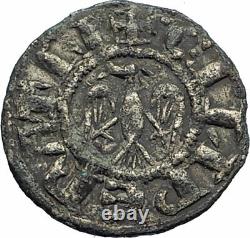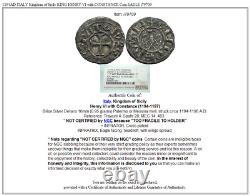1194AD ITALY Kingdom of Sicily KING HENRY VI with CONSTANCE Coin EAGLE i79709




Item: i79709 Authentic Coin of. Reference: Travaini 4; Spahr 28; MEC 14, 483. Because "TOO FRAGILE TO HOLDER" +?
RATRIX, Eagle facing, head left, with wings spread. Note regarding "NOT CERTIFIED by NGC" coins. Certain coins are ineligible types for NGC slabbing because of their very strict grading policy as their experts sometimes uncover things that make them ineligible for their grading service and list this reason. A lot of, or possibly even most collectors could consider the reasons minor or insignificant to the enjoyment of the history, collectibility and beauty of the coin. In the interest of honesty and integrity, this information is disclosed to you so that you can make an informed decision of exactly what you are getting.
Henry VI (Heinrich VI) (November 1165 - 28 September 1197), a member of the Hohenstaufen dynasty, was King of Germany (King of the Romans) from 1190 and Holy Roman Emperor from 1191 until his death. From 1194 he was also King of Sicily. He was the second son of Emperor Frederick Barbarossa and his consort Beatrix of Burgundy. In 1186 he was married to Constance of Sicily, the posthumous daughter of the Norman king Roger II of Sicily. Henry, stuck in the Hohenstaufen conflict with the House of Welf until 1194, had to enforce the inheritance claims by his wife against her nephew Count Tancred of Lecce.Henry's attempt to conquer the Kingdom of Sicily failed at the siege of Naples in 1191 due to an epidemic. Based on an enormous ransom for the release of King Richard I of England, he conquered Sicily in 1194; however, the intended unification with the Holy Roman Empire ultimately failed due to the opposition of the Papacy. Henry threatened to invade the Byzantine Empire after 1194 and succeeded in extracting a ransom, the Alamanikon, from Emperor Alexios III Angelos in return for cancelling the invasion. In 1195 and 1196 Henry attempted to turn the Holy Roman Empire from an elective to a hereditary monarchy, the so-called Erbreichsplan, but met strong resistance from the prince-electors and abandoned the plan. Henry pledged to go on crusade in 1195 and began preparations.
A revolt in Sicily was crushed in 1197. The Crusaders set sail for the Holy Land that same year but Henry died of illness at Messina on 28 September 1197 before he could join them. His death plunged the Empire into the chaos of the German throne dispute for the next 17 years. Constance I (2 November 1154 - 27 November 1198) was Queen regnant of Sicily in 1194-98, jointly with her spouse from 1194 to 1197, and with her infant son Frederick II, Holy Roman Emperor, in 1198, as the heiress of the Norman kings of Sicily.
She was also Holy Roman Empress by marriage to Henry VI, Holy Roman Emperor. While Henry moved quickly south with his army, a pregnant Constance followed at a slower pace. On 26 December, the day after Henry was crowned at Palermo, she gave birth to a son, Frederick-Roger (the future Frederick II, Holy Roman Emperor and King of Sicily) in the small town of Iesi, near Ancona. There is a story that Constance, being 40 after a marriage of 9 years, knew that many would question whether the child was really hers.
Some rumored that she had prepared to claim a son of a butcher her son. Thus she had the baby in a pavilion tent in the market square of the town, and invited the town matrons to witness the birth. Later she was crowned as queen of Sicily at Bari.
In 1196 Henry VI had Richard, Count of Acerra brother of Sibylla hanged in revenge for the capture of Constance. On Good Friday in 1196, Constance summoned Joachim of Fiore to Palermo to hear her confession in Palatine chapel. Initially she sat on a raised chair, but when Joachim told her that as they were at the places of Christ and Mary Magdalene, she needed to lower herself, she sat on the ground. However, the tyranny of Henry for Sicily initiated revolts, especially around Catania and southern Sicily. Henry wanted to placate Sicilians by naming Constance regent, but failed as Constance was merely viewed as his tool and could not stop him from making up Sicilian government dominated by German seneschal Markward von Anweiler and ensured by German troops.
Henry crushed the rebellion of Jordan Lupin who claimed to be king of Sicily and received a gift of jewels from Constance. Henry had Jordan tortured to death in front of Constance in June 1197. Provoked by the neglect of Henry while pitying her countrymen, Constance also joined the revolts against her husband and besieged him in a castle, forcing him into a treaty. Italy, officially the Italian Republic (Italian: Repubblica Italiana), is a unitary parliamentary republic in Europe. Italy covers an area of 301,338 km.
(116,347 sq mi) and has a largely temperate climate; due to its shape, it is often referred to in Italy as lo Stivale (the Boot). With 61 million inhabitants, it is the 4th most populous EU member state. Located in the heart of the Mediterranean Sea, Italy shares open land borders with France, Switzerland, Austria, Slovenia, San Marino and Vatican City. Since ancient times, Greek, Etruscan, Celtic, and other cultures have thrived on the Italian Peninsula.Rome ultimately emerged as the dominant power, conquering much of the ancient world and becoming the leading cultural, political, and religious centre of Western civilisation. The Renaissance led to a flourishing of Italian culture, producing famous scholars, artists, and polymaths such as Leonardo da Vinci, Galileo, Michelangelo and Machiavelli. Italian explorers such as Marco Polo, Christopher Columbus, Amerigo Vespucci, and Giovanni da Verrazzano discovered new routes to the Far East and the New World, helping to usher in the European Age of Discovery.
Nevertheless, Italy remained politically fragmented and fell prey to European powers such as France, Spain, and later Austria, subsequently entering a long period of decline that lasted until the mid-19th century. After various unsuccessful attempts, the second and the third wars for Italian independence resulted in the eventual unification of most of present-day Italy by 1866.From the late 19th century to the early 20th century, the new Kingdom of Italy rapidly industrialised and acquired a colonial empire, becoming a great power. However, southern and rural areas of the country remained largely excluded from industrialisation, fuelling a large and influential diaspora. Despite being one of the main victors in World War I, Italy entered a period of economic crisis and social turmoil, leading the way to the rise of a Fascist dictatorship in 1922.
The subsequent participation in World War II on the Axis side ended in military defeat, economic destruction and civil war. In the years that followed, Italy abolished the monarchy, reinstated democracy, and enjoyed a prolonged economic boom, thus becoming one of the world's most developed nations. Italy has the third largest economy in the Eurozone and the eighth largest economy in the world.
It has a very high level of human development and enjoys the highest life expectancy in the EU. Italy plays a prominent role in global military, cultural and diplomatic affairs and is also considered to be a major regional power in Europe. Italy is a founding and leading member of the European Union and the member of numerous international institutions, including the UN, NATO, the OECD, the OSCE, the WTO, the G7/G8, G20, the Union for the Mediterranean, the Council of Europe, Uniting for Consensus, and many more. As a reflection of its vast cultural wealth, Italy is home to 51 World Heritage Sites, the most in the world, and is one of the most visited countries.World-renowned expert numismatist, enthusiast, author and dealer in authentic ancient Greek, ancient Roman, ancient Byzantine, world coins & more. Ilya Zlobin is an independent individual who has a passion for coin collecting, research and understanding the importance of the historical context and significance all coins and objects represent. Send me a message about this and I can update your invoice should you want this method. Getting your order to you, quickly and securely is a top priority and is taken seriously here. Great care is taken in packaging and mailing every item securely and quickly.
What is a certificate of authenticity and what guarantees do you give that the item is authentic? You will be very happy with what you get with the COA; a professional presentation of the coin, with all of the relevant information and a picture of the coin you saw in the listing. Additionally, the coin is inside it's own protective coin flip (holder), with a 2x2 inch description of the coin matching the individual number on the COA. Whether your goal is to collect or give the item as a gift, coins presented like this could be more prized and valued higher than items that were not given such care and attention to. When should I leave feedback? Please don't leave any negative feedbacks, as it happens sometimes that people rush to leave feedback before letting sufficient time for their order to arrive. The matter of fact is that any issues can be resolved, as reputation is most important to me. My goal is to provide superior products and quality of service. How and where do I learn more about collecting ancient coins? Visit the Guide on How to Use My Store. For on an overview about using my store, with additional information and links to all other parts of my store which may include educational information on topics you are looking for.
